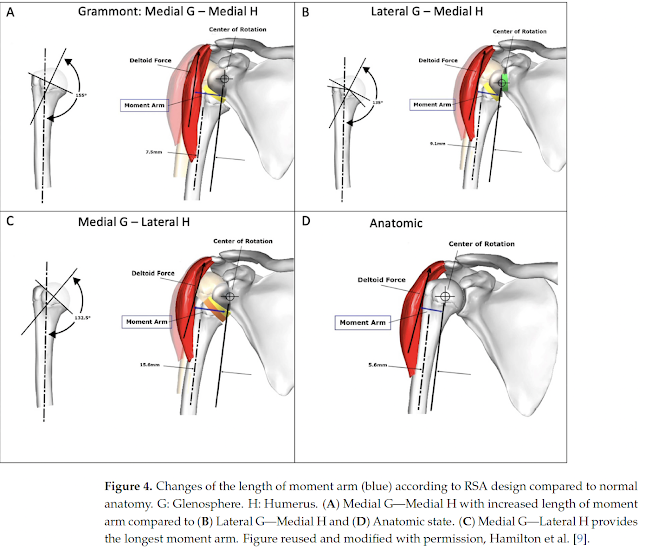Their key findings may be summarized as follows.
(A) In hierachical order, the most important factors for optimizing abduction and adduction range of motion are
(1) lateralizing the gleosphere center of rotation,
(2) distalizing the glenosphere (e.g. by placing the baseplate low, by using a smaller baseplate and/or by using an inferiorly eccentric glenosphere),
(3) inferiorly tilting the glenosphere and
(4) increasing the neck-shaft angle.
(B) Patients with severe kyphosis are at risk for reduced adduction, abduction, external rotation and extension. Higher retrotorsion, lower neck-shaft angle and a larger/inferior glenosphere may be considered.
The effects of offset and superior/inferior position are represented below where the green zone is the impingement-free range of adduction/abduction.
(C) The abduction moment arm is maximized by a medial center of rotation and a lateralized tuberosity.
However, a longer lever arm changes the normal length-tension relationships of the muscle (Blix curve). To optimize fiber recruitment and the length of the contractile elements of the deltoid and residual rotator cuff, the authors recommed placing the tuberosity close to the normal anatomic position.
External rotation, extension and internal rotation are key challenges to the optimization of RSA function. They are substantially improved by the combination of glenoid-sided lateralization, inferior glenosphere overhang, and a decreased neck shaft angle as low as 135 degrees, as outlined in part I of this review.
Lateralization, distalization and inferior glenosphere tilt have been proven to be the three most important factors in hierarchical order to increase glenohumeral ABD by increasing the subacromial space.
Thoracic kyphosis, scapular posture, and motion need to be evaluated, as they may influence planning, positioning, and outcomes of RSA.
Glenoid-sided lateralization (LGMH) and humeral lateralization (MGLH) have different effects on the moment arm but also muscle length for the force generation of RSA.
The total amount of lateralization has been recommended to be close to the anatomical lateralization of the humeral tuberosities; however, the optimal amount of glenoid and humeral contribution is unknown to date.
You can support cutting edge shoulder research that is leading to better care for patients with shoulder problems, click on this link.Thoracic kyphosis, scapular posture, and motion need to be evaluated, as they may influence planning, positioning, and outcomes of RSA.
Glenoid-sided lateralization (LGMH) and humeral lateralization (MGLH) have different effects on the moment arm but also muscle length for the force generation of RSA.
The total amount of lateralization has been recommended to be close to the anatomical lateralization of the humeral tuberosities; however, the optimal amount of glenoid and humeral contribution is unknown to date.
Follow on twitter: https://twitter.com/shoulderarth
Follow on facebook: click on this link
Follow on facebook: https://www.facebook.com/frederick.matsen
Follow on LinkedIn: https://www.linkedin.com/in/rick-matsen-88b1a8133/
Here are some videos that are of shoulder interest
Shoulder arthritis - what you need to know (see this link).
How to x-ray the shoulder (see this link).
The ream and run procedure (see this link).
The total shoulder arthroplasty (see this link).
The cuff tear arthropathy arthroplasty (see this link).
The reverse total shoulder arthroplasty (see this link).
The smooth and move procedure for irreparable rotator cuff tears (see this link).
Shoulder rehabilitation exercises (see this link).




